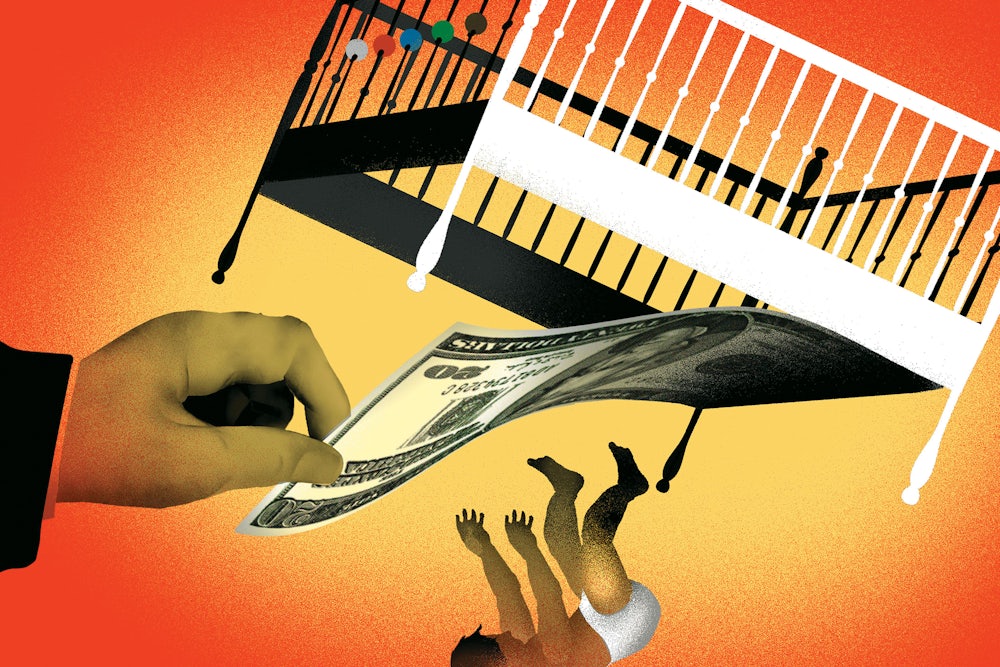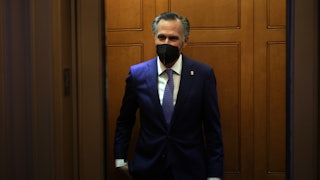Melissa Boyles spends much of her time caring for others. When I talked to her in mid-January, she was making the roughly 45-minute drive from her home of Clarksburg to Buckhannon, West Virginia, to look after an aunt. A former home care worker, the 63-year-old Boyles is the primary caretaker for her teenage granddaughter, Nevaeh. She and her husband, who is unable to work because of myriad health issues, rely on disability benefits to scrape by. Boyles has opted not to get surgery for a recently torn rotator cuff, worried about who’d care for Nevaeh—“heaven” spelled backward—if she was out of commission.
Between July and December, Boyles at least lived with an extra cushion. Hers was one of the roughly 36 million families receiving a monthly payment of the expanded child tax credit, part of the American Rescue Plan that Joe Biden signed in March 2021. With those regular checks, Boyles ensured that Nevaeh ate a bit better and had clothes to cover a recent growth spurt. She bought a dress at a consignment store for Nevaeh’s homecoming dance, a flash of sorely needed teenage normalcy for her granddaughter, who has struggled with depression and receives regular counseling. “It was helping my household, so that I didn’t have to rob Peter to pay Paul,” Boyles said. With the extra financial support each month, she no longer had to choose which bills to pay.
The American Rescue Plan raised the annual child tax credit to $3,600 for children five and under, and to $3,000 for children between the ages of six and 17, for families earning under a certain threshold. In July, the Internal Revenue Service started distributing monthly checks of $300 per child under six and $250 per older child, with caretakers like Boyles able to claim the remaining half of the credit (the amount that would have been distributed if the program had begun in January) on 2021 tax returns. Although the child credit already existed at a lower amount, until last year it had been unavailable to caretakers too poor to file income taxes.
The Build Back Better Act, Democrats’ proposal to invest in education, childcare, and climate, initially included a one-year extension of the expanded credit, and would make permanent the refundability provision that brought in poorer parents and caretakers. But the Democratic senator from Boyles’s state, Joe Manchin, opposes BBB, citing the cost and demanding it come with a work requirement. “I’ve been basically very clear on that,” Manchin reiterated in early January. To get the credit, Manchin has said, families should file a W-2 form showing that they have taxable income. (All Senate Republicans, including Shelley Moore Capito of West Virginia, are uniformly opposed to BBB.) The expanded child tax credit—both its higher cash amounts and the refundability aspect that was so key to poor families—expired at the end of December.
“Why should my granddaughter not get it because me and my husband are disabled?” Boyles said about Manchin’s stipulation on work requirements. “I didn’t ask to be raising a 16-year-old at 63.” Ironically, one of the concerns Manchin raised, falsely, was that the benefit would be inaccessible to grandparents raising their grandchildren. Grandparents are able to receive the credit if they claim their grandchildren as dependents.
“Look, buddy,” Boyles said about Manchin, “how about you pay attention to the people that put you in office and see what you can do to help us?”
It can often take years to see the full effects of public policy changes. But there’s already a plethora of data showing the 2021 tax credit’s effectiveness in benefiting children. In December, the program kept 3.7 million children out of poverty, according to a report by the Center on Poverty and Social Policy at Columbia University. On its own, the credit reduced monthly child poverty by nearly 30 percent. The advance child tax credit payments were also associated with a roughly 26 percent decrease in household food insufficiency, according to a January study by a group of academics associated with the Boston University School of Public Health. “We don’t have many programs where we get such incredible information about the impact it’s having,” said Representative Suzan DelBene of Washington state, who has been a champion in the House for extending the expanded credit.
Census data shows the most common uses of the payments were purchasing food, paying bills, and buying children’s clothes and other essentials. Other frequent uses included paying off debt, school tuition and supplies, and covering activities for children.
For Andrea Knauber, an immigrant from Colombia raising her 11-year-old daughter alone on a public school teacher’s salary in Florida, the monthly payment provided a sorely needed cushion. She used the extra money to pay for counseling sessions for her daughter—which her health insurance stopped covering—and dance lessons. “This child credit has allowed me to do something for my daughter that I don’t consider extra,” Knauber said. “She should be receiving mental health services on a regular basis, and she should be able to [be] involved in the arts.”
Knauber has limited options, thanks to student loan and credit card debt. If she needs to get her car repaired, or take the dog to the vet, she has to put it on her credit card. She worries about the resumption of student loan repayments in May. Since she will no longer be receiving the monthly child credit, Knauber said, she has reduced the counseling sessions for her daughter and is asking family members for assistance to pay for the dance lessons. “If I don’t have the money for that, then it just doesn’t happen.”
If the benefits of extending the credit are apparent, so are the risks of allowing it to expire. Nearly 10 million children could slip back below the poverty line or deeper into poverty. The Center on Poverty and Social Policy estimated that the child poverty rate could increase by at least 5 percent in early 2022. Sophie Collyer, a research director at the Columbia center, said that the lapse in the program would likely lead to “higher rates of hardship, particularly food hardship.”
Evidence shows that, rather than discouraging people from seeking jobs—as opponents such as Manchin claim—the policy makes it easier for families to pay for childcare, and thus to hold down jobs. Between July and September, one in 10 families used the credit to pay for childcare, according to census data. Another report, by the National Academies of Sciences, Engineering, and Medicine, found in 2019 that the vast majority of people in low-income households would continue to work even with a benefit of $3,000 per child, and that most would not reduce their work hours. “Families actually have used the child tax credit to help get back to work,” DelBene said, relating stories she’d heard from constituents about parents making “car repairs so that they were able to get back to work.”
Collyer said that allowing the program to lapse now meant halting changes that were just beginning to take effect. “Right now, there’s the immediate impact of this rollback on families and kids,” she said, “but we’re also compromising the long-term societal benefits that we derive from this policy by rolling it back.”
The policy is one of the most clear-cut successes of the first year of Joe Biden’s presidency. If it became permanent, it could be the most meaningful expansion of the welfare state since LBJ’s Great Society. Yet, in mid-January, Biden acknowledged that the credit likely won’t be in the final version of BBB, even if an agreement can be reached. “There’s two really big components that I feel strongly about,” Biden said at a press conference, “that I’m not sure I can get in the package: One is the childcare tax credit, and the other is help for cost of community colleges.”
Biden’s statement came four days after January 15, when parents and caretakers, for the first time since July, would no longer be receiving the extra monthly support. Boyles told me in a text message that she was “revising [her] budget” to accommodate the loss of the monthly payment. When I told her about Biden’s comments and asked her if she was worried Washington was giving up on the credit, she replied, “absolutely,” followed by a broken heart emoji.
In our conversation earlier in January, Boyles said she wanted politicians to understand that “real people are being affected” by the loss of the expanded credit. “I’m not the only grandparent my age or older raising my grandkids,” she said. (More than 54 percent of the grandparents in West Virginia who live with their grandchildren act as the primary caretakers for those kids, according to 2019 census data, the second-highest percentage of any state in the country.) Boyles added that she was willing to drive to Manchin’s office in Charleston, the capital of West Virginia, to speak with the senator about the credit.
“He needs to see what’s going on in the real world.”
This article appeared in the March 2022 print edition with the headline “Robbing the Cradle.”






